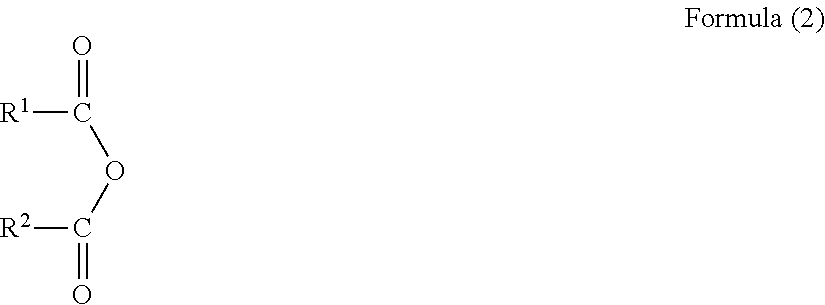Highly soluble modified epoxy resin composition
a technology of modified epoxy resin and composition, which is applied in the field of liquid modified epoxy resin, can solve the problems of low recovery, low solubility, and inability to meet strict requirements for improving curing characteristics, and achieve high melting point-type, high solubility, and high preservation stability
- Summary
- Abstract
- Description
- Claims
- Application Information
AI Technical Summary
Benefits of technology
Problems solved by technology
Method used
Image
Examples
synthesis example 1
[0100]To a reaction flask having an inner volume of 2 liters and equipped with a stirrer, 30 g of water, 5.5 g of tetramethylammonium chloride, 1,388 g (15 mol) of epichlorohydrin, and 129 g (1 mol) of isocyanuric acid were placed to form a reaction mixture. Next, the reaction mixture in the flask was heated with stirring to elevate a temperature. When the temperature of the reaction mixture reached 89° C., the reaction mixture started to be boiled under atmospheric pressure; however, the reaction mixture was continued to be heated. Generated steam was cooled in a condenser, all of liquefied epichlorohydrin was sequentially refluxed in the flask, and liquefied water was discharged out of the flask. These processes were performed to be continued for five hours to allow the temperature of the reaction mixture to reach 120° C. Then heating was stopped at this time point, and the reaction mixture was cooled to obtain a reaction product whose temperature was 45° C. Unreacted isocyanuric ...
synthesis example 2
[0103]80.0 kg (269 mol) of the highly pure tris-(2,3-epoxypropyl)-isocyanurate manufactured in Synthesis Example 1 and 680 kg of acetone were mixed, and stirred at 9° C. After that, crystals were filtered to obtain a filtrate containing a high proportion of the α-type. The filtrate was vacuum concentrated at 40° C., 243 kg of methanol was added thereto, and the mixture was cooled to 20° C. After that, the mixture was filtered, and the obtained crystals were vacuum dried to obtain 37.3 kg (125 mol) of tris-(2,3-epoxypropyl)-isocyanurate (in crystalline bodies, the mass ratio of α crystals:β crystals=98:2).
synthesis example 3
[0104]5.0 g (17 mmol) of the highly pure tris-(2,3-epoxypropyl)-isocyanurate manufactured in Synthesis Example 1 and 42.5 g of epichlorohydrin were mixed, and stirred at 6° C. After that, crystals were filtered to obtain a filtrate containing a high proportion of the α-type. 785 g of methanol was added thereto, and the mixture was cooled to −78° C. After that, the mixture was filtered, and the obtained crystals were vacuum dried to obtain 3.2 g (11 mmol) of tris-(2,3-epoxypropyl)-isocyanurate (in crystalline bodies, the mass ratio of α crystals:β crystals=92:8).
PUM
| Property | Measurement | Unit |
|---|---|---|
| Percent by mass | aaaaa | aaaaa |
| Percent by mass | aaaaa | aaaaa |
| Percent by mass | aaaaa | aaaaa |
Abstract
Description
Claims
Application Information
 Login to View More
Login to View More - R&D
- Intellectual Property
- Life Sciences
- Materials
- Tech Scout
- Unparalleled Data Quality
- Higher Quality Content
- 60% Fewer Hallucinations
Browse by: Latest US Patents, China's latest patents, Technical Efficacy Thesaurus, Application Domain, Technology Topic, Popular Technical Reports.
© 2025 PatSnap. All rights reserved.Legal|Privacy policy|Modern Slavery Act Transparency Statement|Sitemap|About US| Contact US: help@patsnap.com



